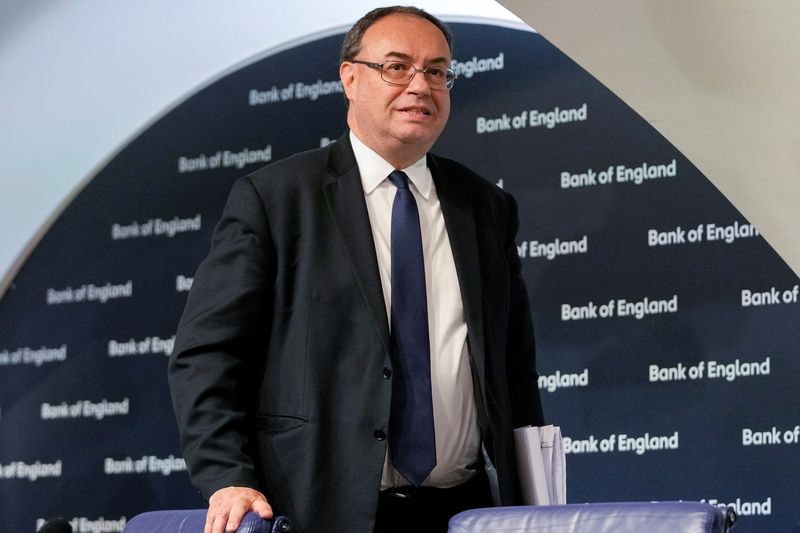LONDON (Reuters) - In a race to get on top of surging inflation, central banks in the United States, Britain and Australia, all jacked up interest rates this week.
Stubbornly high inflation also prompted Iceland to lift rates by one percentage point on Wednesday, and India delivered an unscheduled rate rise.
Some, such as the Bank of England, worry their economies are headed for recession, but that ha not stopped them from signalling more hikes are coming.
Here is a look at where policymakers stand on the path out of the pandemic-era stimulus, ranked in terms of hawkishness.
1) NORWAY
Norway's central bank, Norges Bank, kept rates on hold on Thursday after hiking them by a quarter point to 0.75% in March, when it announced plans to tighten policy more quickly than previously planned.
It plans to hike again in June and raise rates to 2.50% by end-2023, with three more hikes than projected previously.
2) NEW ZEALAND
The Reserve Bank of New Zealand is one of the world's most hawkish central banks.
It raised its cash rate last month by 50 bps to 1.5%, the biggest rise in two decades and the fourth hike in this cycle. With inflation at 30-year highs, markets expect another 50 bps hike this month -- the RBNZ forecasts rates will peak around 3.35% by end-2023.
3) CANADA
The Bank of Canada kicked off its rate-rise cycle in March, and raised rates last month by 50 bps to 1%, its biggest single move in over two decades.
It is also letting maturing bonds roll off its balance sheet. BoC Governor Tiff Macklem reckons rates are still far below neutral levels, estimated between 2%-3%. Markets expect rates to approach 3% by year-end, with another half-point rise seen on June 1.
4) BRITAIN
The BoE hiked rates to 1% on Thursday, their highest since 2009, to tame inflation it now forecasts will top 10% this year.
Policymakers also hardened their language on the need for more tightening in the coming months, so much so that two of the nine BoE rate setters called the guidance too strong given the risk of Britain falling into recession.
Markets expect rates to reach 2%-2.25% by end-2022.
5) UNITED STATES
The Federal Reserve on Wednesday raised its key rate by 50 bps, the biggest jump in 22 years, and markets were relieved that the Fed did not go with a 75 bps move.
Still, the Fed said it was ready to deliver more half-point hikes and plans next month to start reducing its $9 trillion stash of assets accumulated during the coronavirus pandemic to help bring inflation under control.
6) AUSTRALIA
The Reserve Bank of Australia raised rates by 25 bps to 0.35% on Tuesday and flagged more ahead. Having insisted for months that rate hikes were way off, the RBA finally joined the rate-rise club.
The policy sea-change came after data showing first-quarter consumer inflation spiking to 20-year peaks of 5.1%. Core inflation hit 3.7%, above the RBA target band for the first time since 2010.
Futures pricing points to rates reaching 2.5% by end-2022 and 3.5% by mid-2023, which would be the most aggressive RBA tightening cycle in modern history.
7) SWEDEN
A late-comer to the inflation battle, Sweden's Riksbank last week notched up rates by 25 bps to 0.25% to contain inflation running at its highest since 1991 at above 6%.
The Riksbank's policy rate is now positive for the first time since 2014. It had said as recently as February that rates were not expected to rise until 2024. Now it expects to hike two or three more times this year, with more next year to take rates above 1%.
8) EURO ZONE
The dovish European Central Bank has become more hawkish given record-high inflation at 7.5%.
ECB board member Isabel Schnabel said this week rates may need to rise as soon as July. A precursor to any rate hike must be the end of bond purchases, and this could come at the end of June, she added.
Markets price 90 bps of tightening this year, meaning the key -0.50% depo rate could exit negative territory soon.
9) SWITZERLAND
The Swiss National Bank remains firmly dovish even though Swiss inflation surged to 2.4% in March, well above the SNB's price stability goal of 0%-2%.
It has refused to signal higher rates, insisting that a strong franc helps guard against inflation.
10) JAPAN
The Bank of Japan remains the holdout dove.
Last week it strengthened its commitment to keep rates ultra-low by vowing to buy unlimited amounts of bonds to defend a bond yield target. That sent the yen to two-decade lows against the dollar.

Japan's core consumer prices rose at their fastest pace in more than two years in March, but a fragile economy means the BOJ is no rush to tighten policy.
($1 = 0.9329 Swiss francs)